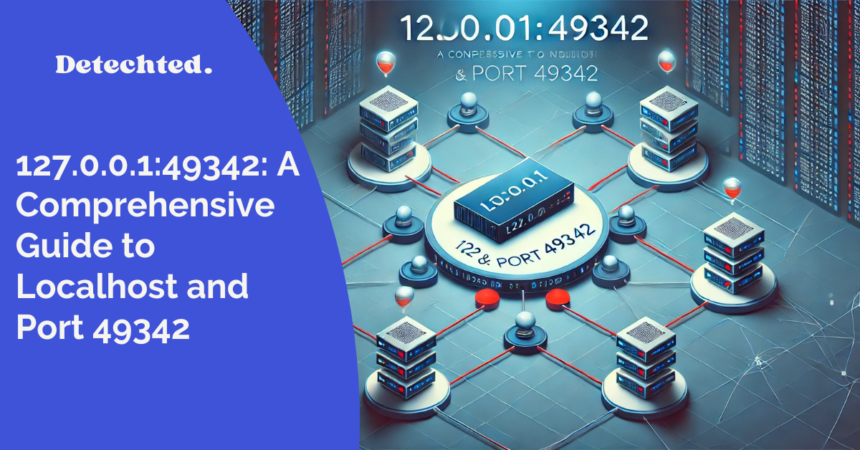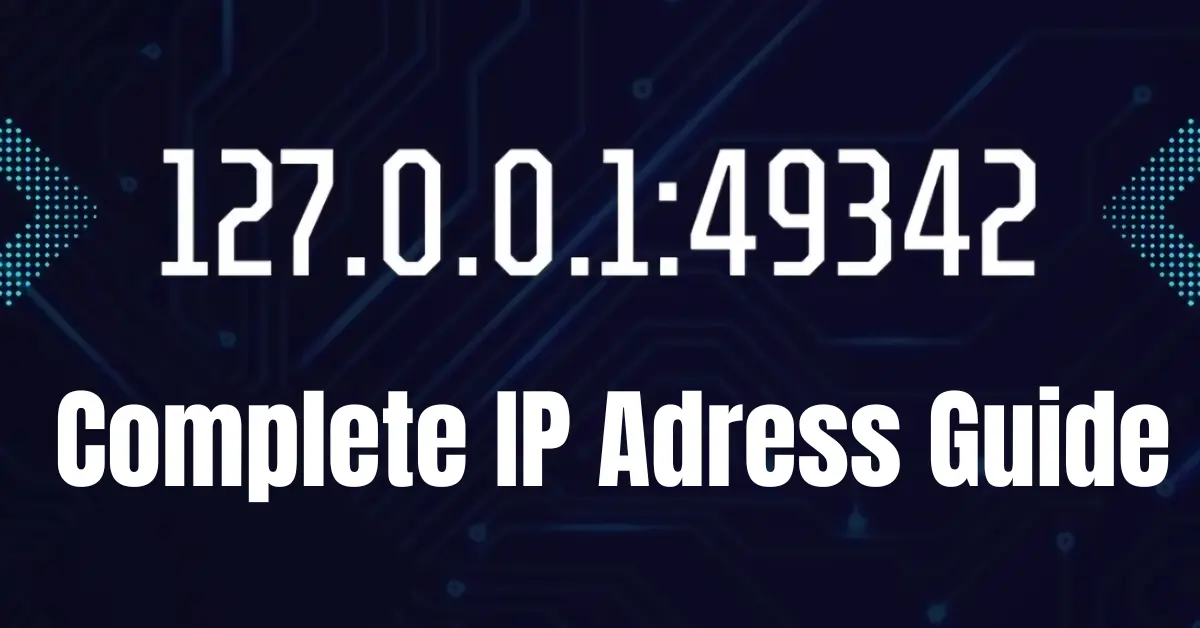Everything You Need to Know About 127.0.0.1:49342- A Closer Look
Introduction to 127.0.0.1:49342 and its significance

Welcome to the mysterious world of 127.0.0.1:49342 – a digital realm filled with endless possibilities and untapped potential. In this blog post, we will take a closer look at the enigmatic IP address and port combination that has piqued the curiosity of tech enthusiasts and novices alike. Join us on a journey through the origins, workings, uses, risks, and precautions associated with 127.0.0.1:49342 as we unravel its secrets together!
The History and Origins of 127.0.0.1:49342
Let’s take a journey back in time to unravel the history and origins of 127.0.0.1:49342. This unique combination of IP address and port number has a fascinating background that traces back to the development of networking protocols.
The concept of IP addresses dates back to the early days of ARPANET, the precursor to today’s internet. As technology evolved, the need for standardized communication led to the creation of IPv4 addresses like 127.0.0.1.
Ports, on the other hand, were introduced to allow multiple applications on a single device to communicate simultaneously over a network. The specific port number 49342 is just one out of thousands available for various uses.
Understanding this history sheds light on how modern networks operate and highlights the intricacies behind seemingly simple combinations like 127.0.0.1:49342.
Understanding IP Addresses and Ports
IP addresses and ports are essential components of networking that allow devices to communicate with each other. An IP address serves as a unique identifier for a device on a network, much like a home address in the physical world. It consists of four sets of numbers separated by periods, such as 127.0.0.1.
On the other hand, ports act as endpoints for communication within a single device. They help distinguish between different types of traffic coming in and out of the device, similar to different doors leading into a building serving various purposes.
When combined, an IP address and port create a specific destination for data packets to reach their intended recipient efficiently. Understanding how these elements work together is crucial for troubleshooting network issues and ensuring smooth communication between devices across networks worldwide.
How to Use 127.0.0.1:49342 for Testing and Troubleshooting
If you’re delving into the realm of testing and troubleshooting, 127.0.0.1:49342 can be a valuable tool in your tech arsenal. This unique IP address allows you to loop back to your device, creating a closed network environment for various purposes.
By utilizing this address along with the designated port number 49342, developers and IT professionals can simulate different scenarios without impacting external systems or networks. It serves as a sandbox for testing applications, websites, or network configurations in isolation.
When troubleshooting connectivity issues or software bugs, directing traffic to 127.0.0.1:49342 enables you to pinpoint problems within your local setup without interference from external factors.
Remember to leverage this resource responsibly and ethically; improper use could potentially pose security risks if not handled with caution and expertise.
Potential Security Risks and Precautions for Using 127.0.0.1:49342
When it comes to using 127.0.0.1:49342 for testing and troubleshooting, there are some security risks that users should be aware of. Since this IP address is commonly used for local development purposes, it is not meant to be exposed to the internet. However, if misconfigured or left open unintentionally, it could potentially become a point of entry for malicious actors.
One precaution to take when utilizing 127.0.0.1:49342 is to ensure that any services or applications listening on this port are securely configured and up-to-date with the latest patches and security measures in place.
Regularly monitoring network traffic and logs can also help in detecting any unauthorized access attempts or suspicious activities related to this IP address.
In addition, implementing firewalls and access controls can further enhance the security posture of systems utilizing 127.0.0.1:49342 by restricting access only to authorized users or devices.
Applications of 127.0
When it comes to the applications of 127.0, this IP address holds significant value in the realm of networking and software development. One common use is for testing purposes, where developers can simulate network environments on their local machine using 127.0.0.1:49342 to ensure that their applications function correctly before deployment.
Moreover, 127.0 can also be utilized for troubleshooting network issues within a closed system, allowing users to isolate problems and debug connections effectively without affecting external networks or servers.
Additionally, this IP address serves as a valuable tool for running local servers and services on an individual’s computer without needing internet access. By leveraging 127.0, users can host websites, APIs, or databases locally for development and testing purposes.
The versatility of 127.0 makes it a fundamental component in various IT-related tasks and projects across different industries worldwide.
Introduction to 127.0.0.1:49342
Welcome to the mysterious world of 127.0.0.1:49342, a unique IP address and port combination that holds intrigue for tech enthusiasts and professionals alike. This specific address is commonly known as the localhost, allowing devices to communicate with themselves.
Originating from the concept of loopback interfaces in networking, 127.0.0.1:49342 serves as a virtual playground for testing and troubleshooting applications without impacting external networks.
Understanding how this IP address functions can unlock a realm of possibilities for developers seeking to fine-tune their software or diagnose issues within a controlled environment.
By harnessing the power of 127.0.0.1:49342, individuals can simulate network scenarios, run diagnostics on web servers, or isolate problems in complex systems with precision.
Delve into the depths of 127.
What is the Purpose of This IP Address?
Ever wondered what the purpose of the IP address 127.0.0.1:49342 is? This unique address is known as the loopback address, allowing a device to send and receive data with itself for testing purposes. It’s like sending a letter to your mailbox just to check if it reaches its destination without involving external networks.
This special IP address serves as a way for developers and network engineers to troubleshoot applications without impacting live systems or relying on external servers. By using 127.0.0.1:49342, they can simulate interactions within their machine, ensuring that everything functions correctly before deployment.
In essence, this IP address acts as a virtual playground for testing software and diagnosing network issues locally. Its significance lies in its ability to streamline development processes and enhance system reliability through self-contained evaluations.
With an understanding of its purpose, you can leverage 127.0.0.1:49342 effectively in your technical endeavors, fostering smoother workflows and more robust digital solutions.
How Does it Work?
Have you ever wondered how 127.0.0.1:49342 works? Let’s dive into the mechanics behind this intriguing IP address and port combination.
When you type in 127.0.0.1:49342 into your browser, your device is essentially looping back to itself through the localhost address, also known as the loopback address.
This process allows for testing and troubleshooting applications without needing an external network connection – pretty handy, right?
By using this specific IP address and port number, data packets are directed internally within your device rather than being sent out to a network.
The unique port number serves as a channel for communication between different applications running on your device, ensuring that data is transmitted accurately to the intended destination.
In essence, understanding how 127.0.0.1:49342 works gives you insight into its functionality and versatility across various testing scenarios.
Common Uses of 127.0.0.1:49342

When it comes to the common uses of 127.0.0.1:49342, one primary application is for testing and troubleshooting network connections on your local machine. Developers often utilize this IP address along with the designated port to simulate interactions between different software components without affecting external systems.
Moreover, 127.0.0.1:49342 can also be employed for running server programs locally for debugging purposes before deploying them in live environments. This practice allows developers to identify and rectify any issues or bugs in their code efficiently.
Furthermore, some applications use this specific IP address and port combination as a default setting for certain services that require communication within the same device or virtual environment.
In essence, understanding how to leverage 127.0.0.1:49342 effectively can greatly streamline development processes and enhance overall system performance by providing a controlled environment for testing various functionalities seamlessly on your machine without impacting external networks.
Potential Risks and Security Concerns
When using 127.0.0.1:49342 for testing and troubleshooting, it is essential to be aware of potential security risks that come with it. One risk is exposing sensitive information on your local machine to unauthorized users if not properly secured.
Another concern is the possibility of malware or hackers exploiting vulnerabilities in the system through this IP address and port combination. It’s crucial to regularly update your security software and firewall settings to mitigate these risks.
Additionally, using 127.0.0.1:49342 without caution could inadvertently open doors for cyberattacks such as denial-of-service attacks or data breaches.
To safeguard against these threats, always use strong passwords, encrypt sensitive data, and limit access to only trusted individuals when utilizing this IP address for any purpose.
Stay vigilant and proactive in protecting your system from potential risks associated with 127.0.0.1:49342 to ensure a secure testing environment at all times.
Tips for Managing and Protecting Your IP Address
When it comes to managing and protecting your IP address, there are some essential tips to keep in mind. Always ensure that your network has a strong firewall in place to block any unauthorized access attempts. Regularly update your software and operating systems to patch any vulnerabilities that could be exploited by cyber attackers.
Additionally, be cautious about the information you share online and avoid clicking on suspicious links or downloading attachments from unknown sources. Use encryption tools like VPNs when browsing the internet to protect your data from prying eyes.
Furthermore, consider using complex passwords and two-factor authentication for an added layer of security. It’s also advisable to regularly monitor your network traffic for any unusual activity that could indicate a breach.
By staying proactive and implementing these tips, you can better manage and safeguard your IP address from potential threats.
Conclusion
Understanding the significance of 127.0.0.1:49342 as a vital IP address and port combination is crucial for anyone involved in network testing and troubleshooting. By comprehending its history, applications, potential security risks, and best practices for usage, you can leverage this tool effectively while safeguarding your systems against vulnerabilities. Remember to stay informed about updates and maintain vigilance when utilizing 127.0.0.1:49342 to ensure smooth operations and secure connectivity in your network environment.



